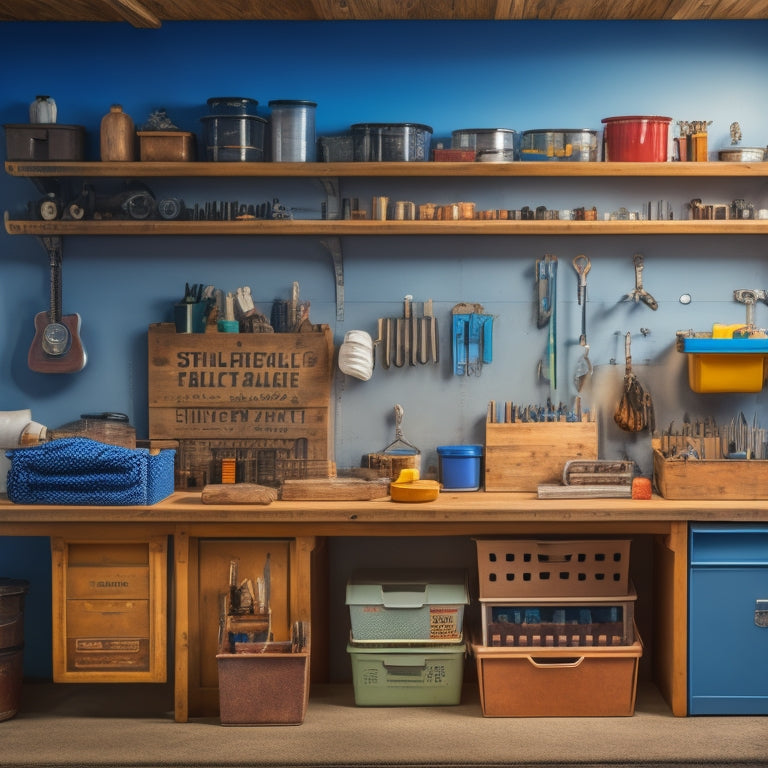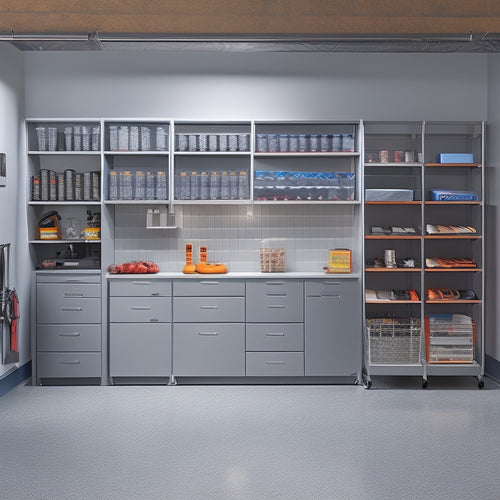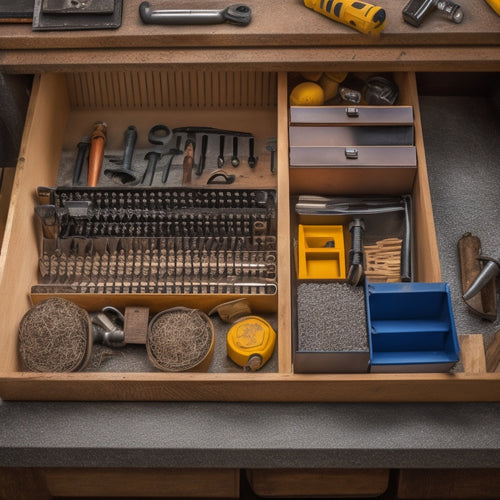
Small Parts Storage Bins for Organizing Workspaces
Share
You need an organized workspace to enhance productivity, and an essential step in achieving this is implementing an efficient small parts storage system that helps you quickly locate and retrieve components. By using small parts storage bins, you'll improve workflow and productivity, enhance inventory management, and reduce risks of stockouts and overstocking. When choosing the right storage bins, consider factors like bin size, weight capacity, accessibility, and material choice. With the right bins, you'll optimize inventory levels, minimize waste, and create a safer working environment. Now, investigate the various types of small parts storage options and design strategies to take your workspace organization to the next level.
Key Takeaways
- Selecting the right storage bin size, weight capacity, and material ensures efficient storage and retrieval of small parts in the workspace.
- Implementing small parts storage bins enhances workflow and productivity by reducing clutter, minimizing waste, and promoting a safe working environment.
- Adjustable compartment bins, stackable parts trays, and clear visibility containers offer flexibility and customization for optimal small parts organization.
- Effective storage space efficiency is achieved through stackable bins, clear labeling, and compact storage solutions that utilize available space effectively.
- Small parts storage bins are ideal for organizing workstations, tool cribs, and supply areas, reducing downtime and promoting a clutter-free workspace.
Benefits of Small Parts Storage
As you investigate the world of small parts storage, you'll quickly realize that organizing these tiny components can greatly impact your workflow and overall productivity. By implementing an effective small parts storage system, you'll be able to efficiently locate and retrieve the components you need, reducing downtime and increasing the overall efficiency of your operation.
Proper inventory management is a critical aspect of small parts storage. By keeping your parts organized, you'll be able to accurately track your inventory levels, reducing the risk of stockouts and overstocking. This, in turn, will help you to optimize your inventory levels, reducing waste and saving you money.
A well-organized workspace also has a significant impact on workspace aesthetics. Cluttered and disorganized workspaces can be hazardous, increasing the risk of accidents and injuries. By keeping your small parts organized and stored away, you'll create a safer, more efficient working environment that promotes productivity and reduces the risk of accidents.
Choosing the Right Storage Bin
When selecting a small parts storage bin, you'll need to take into account the bin's size and capacity to verify it can hold the number of parts you need to store.
You'll also want to think about the storage bin materials, as they can affect the bin's durability, ease of cleaning, and resistance to corrosion.
Bin Size and Capacity
Five key factors determine the ideal bin size and capacity for your small parts storage needs. When selecting a bin, you'll want to take into account the size and quantity of the parts you need to store, the available storage space, the weight capacity required, the accessibility needs, and the overall workflow efficiency.
To guarantee you choose the right bin, take into account the following:
-
Bin dimensions: Measure the space where the bin will be stored to determine the maximum size that will fit comfortably. Also, take into account the size of the parts you need to store to confirm they fit within the bin.
-
Weight capacity: Calculate the total weight of the parts you plan to store and select a bin that can safely hold that weight to prevent damage or collapse.
-
Accessibility: Consider the frequency of access and the ease of retrieval to determine the best bin size and layout.
- Workflow efficiency: Think about how the bin will be used in your workflow and choose a size that minimizes disruptions and maximizes productivity.
Storage Bin Materials
You've determined the ideal bin size and capacity for your small parts storage needs, now it's time to focus on the material that will house your precious components. The material choice is essential, as it directly impacts the durability, safety, and eco-friendliness of your storage solution.
Metal storage bins are a popular choice due to their strength, corrosion resistance, and ability to withstand heavy loads. They're ideal for storing heavy or sharp parts, and their smooth surfaces make them easy to clean. However, metal bins can be noisy, and their weight may make them difficult to move around.
If you're looking for an eco-friendly option, consider bins made from recycled materials or sustainable resources. Eco-friendly bins are perfect for storing small, lightweight parts and are a great way to reduce your carbon footprint.
They're often made from breathable materials, which prevent moisture buildup and reduce the risk of component damage. When choosing eco-friendly bins, verify they meet your specific storage needs and comply with relevant industry standards.
Types of Small Parts Storage
You'll find that small parts storage solutions come in various forms, each designed to cater to specific needs.
You can opt for plastic storage containers that offer a versatile and affordable solution, or stackable parts trays that maximize vertical storage space.
Additionally, adjustable compartment bins provide a customizable storage option that can be adapted to your specific inventory.
Plastic Storage Containers
With a multitude of options available, plastic storage containers have become a staple in small parts storage solutions. You can choose from a wide range of sizes, shapes, and materials to fit your specific needs.
When selecting plastic storage containers, consider the following key factors:
-
Durability: Look for containers made from heavy-duty plastic that can withstand the rigors of daily use and potential impacts.
-
Color coding: Use different colored containers to categorize and organize parts by type, size, or project, making it easier to find what you need quickly.
-
Clear visibility: Opt for transparent or translucent containers that allow you to see the contents without having to open them, saving time and reducing errors.
- Stackability: Select containers with a design that allows for secure stacking, maximizing your storage space and keeping your workspace organized.
Stackable Parts Trays
How do you keep your small parts organized and within reach when working on a project? Stackable parts trays are an excellent solution, offering stackable versatility and efficient organization.
These trays are designed to maximize storage capacity while minimizing workspace clutter. You can stack them on top of each other, creating a compact and accessible storage system.
Each tray typically has individual compartments or cells, allowing you to separate and categorize your small parts. This prevents mixing or losing components, ensuring you can quickly find what you need.
The compartments are often removable, making it easy to clean and maintain the trays.
Adjustable Compartment Bins
Flexibility is key when it comes to storing small parts, and adjustable compartment bins provide the ultimate in customization. You can create a storage system that adapts to your specific needs with these bins. They often feature flexible dividers that can be rearranged or removed as needed, allowing you to create customizable layouts that accommodate parts of various sizes and shapes.
Some benefits of adjustable compartment bins include:
-
Easy reconfiguration: Quickly adjust the layout of your bin to accommodate new or changing inventory.
-
Maximized storage capacity: Make the most of your storage space by creating custom compartments that fit your specific parts.
-
Reduced clutter: Keep your workspace organized and clutter-free by storing small parts in designated compartments.
- Improved inventory management: Easily identify and access the parts you need with a customized storage system.
Designing an Organized Workspace
A well-designed workspace is a productivity powerhouse, where every tool and component has its designated spot, allowing you to focus on the task at hand. When designing your workspace, consider the importance of workspace aesthetics. A visually pleasing environment not only enhances morale but also reduces stress and increases focus.
Begin by identifying the tasks you'll be performing and the tools you'll need. Assign a designated spot for each item, ensuring that frequently used tools are within easy reach. This clutter reduction strategy will save you time and energy in the long run.
Implementing small parts storage bins will help keep your workspace organized and tidy. By doing so, you'll minimize the risk of accidents caused by tripping over clutter or misplacing critical components.
A well-organized workspace isn't only more efficient but also safer. By designing your workspace with intention and purpose, you'll be able to work more efficiently and effectively, ultimately leading to heightened productivity and reduced downtime.
Maximizing Storage Space Efficiency
As you implement small parts storage bins to keep your workspace organized, you're likely to encounter space constraints that can hinder your productivity.
To maximize storage space efficiency, it's vital to optimize the use of available space and reduce clutter.
Here are some strategies to help you achieve space optimization and clutter reduction:
-
Stackable storage bins: Use stackable bins to maximize vertical space and minimize floor usage.
-
Labeling and categorization: Clearly label and categorize your storage bins to guarantee easy access and reduce time spent searching for parts.
-
Compact storage solutions: Consider using compact storage solutions, such as drawer organizers or wall-mounted bins, to make the most of available space.
- Regular inventory management: Regularly manage your inventory to remove unnecessary items, reduce clutter, and optimize storage space.
Common Applications and Uses
Your workshop or factory floor is a lively hub of activity, where every minute counts and every inch of space matters. You need a reliable system to keep your small parts and components organized, easily accessible, and inventoried. Small parts storage bins are the perfect solution for common applications like inventory management and workspace decluttering.
You can use them to store fasteners, electrical components, nuts and bolts, screws, and other small items. By categorizing and labeling each bin, you can quickly locate the parts you need, reducing downtime and increasing productivity. They're also ideal for organizing workstations, tool cribs, and supply areas.
In addition, small parts storage bins help you maintain a safe working environment by keeping floors and work surfaces clear of clutter, reducing tripping hazards, and preventing accidents.
Frequently Asked Questions
Can I Customize Small Parts Storage Bins to Fit My Specific Needs?
You can create custom bin designs that cater to your specific requirements; many manufacturers offer personalized storage solutions, allowing you to tailor the size, material, and features to guarantee a safe and efficient workspace.
How Do I Prevent Small Parts From Getting Damaged in Storage?
Did you know 30% of inventory damage occurs during storage? To prevent damage, you'll want to select storage solutions with cushioning, dividers, and secure closures, ensuring fragile parts are protected and organized, and implementing damage prevention measures like desiccant packets and ESD protection.
Are Small Parts Storage Bins Suitable for Outdoor or Harsh Environments?
When storing small parts outdoors, you'll want bins made from weather-resistant materials to protect them from harsh conditions. For outdoor organization, look for bins with UV-resistant polypropylene or polyester construction to guarantee durability and safety in extreme temperatures and weather.
Can I Stack Small Parts Storage Bins to Save Floor Space?
When maximizing your facility's vertical real estate, you'll want to employ clever stacking techniques to optimize space. Yes, you can safely stack these bins, guaranteeing stability by aligning them properly and avoiding overloading to prevent accidents and guarantee space optimization.
Are Small Parts Storage Bins Easy to Clean and Maintain?
When maintaining your workspace, you'll find that storage bins are easy to clean and maintain; simply wipe them down with gentle cleaning materials and follow basic maintenance tips to prevent dust buildup and guarantee a safe working environment.
Conclusion
As you gaze upon your newly organized workspace, you can't help but notice the irony - the smallest components of your project now hold the greatest significance. It's no coincidence that the tiny parts, once scattered and lost, now have a designated home, much like how your newfound sense of control and efficiency has brought order to your work. With small parts storage bins, the smallest details add up to make a big impact.
Related Posts
-

Small Storage Bins to Maximize Shelf Space
When maximizing shelf space, you want to make the most of every inch. Small storage bins are the answer, but choosing...
-

Building a Garage Storage System With Built-Ins
You're about to build a garage storage system with built-ins that fits your unique needs, starting by evaluating your...
-

Best Screw Storage Bins for Organizing Your Toolbox
You need a reliable screw storage system to maximize your productivity and efficiency, and that's exactly what the ri...


